Common duckweed is an invasive aquatic plant that multiplies quickly and can blanket a pond in no time. This can make a once beautiful pond, rather green and unsightly and is usually the result of a high nutrient load. I’ll give you some natural solutions to this green pond problem.
These free-floating plants can multiply rapidly and quickly cover a pond’s surface, choking out desirable aquatic plants and depleting oxygen levels, ultimately leading to fish death.
A Wide-Spread Problem (literally)
I have had many meetings with people who have a great pond in a beautiful setting, but it is covered with duckweed. They have tried raking it out and bucketing it out to no avail; it just keeps coming back. In perfect growing conditions, a duckweed plant can multiply ten times in a couple of weeks, so raking a bit out on the weekend surely isn’t going to cut it. This problem seems to be very wide-spread and isn’t limited to any particular area or style of pond.
Tools to Help
As mentioned above, large floating style rakes, skimmers, buckets, fine netting and baskets on long poles are all potential solutions that have been tried by people that I’ve met with. All of these things will help, but the duckweed spreads so quickly, that it could almost be your full time job trying to eliminate it.
Some companies make floating devices with long ropes so that with one person walking along each edge of the pond, you can pull the floating net across the surface of your pond drag it the length of your pond and skim off all of the duckweed. These devices work, but the edges of your pond must be free of obstacles such as trees and shrubs. Even if your pond is wide open and clear all around, it is still not an easy task, and you will be left with a large pile of duckweed on one end of the pond that will need to be scooped out onto dry land so that it doesn’t simply spread back across the pond.
Animals to Help
There are animals that eat duckweed, so getting some in your pond will certainly help. However, if your pond is already covered over, it will take a bunch of really hungry animals to make a dent in the duckweed population.
Ducks (of course), geese, grass carp, koi, goldfish, turtles, and beavers are all known to eat duckweed. Be aware that grass carp are heralded as some voracious duckweed eaters, but they are also considered an invasive species and outlawed in many states, such as Wisconsin, where we are located. I would certainly not hesitate to add a bunch of koi and goldfish to a pond full of duckweed. The goldfish reproduce quickly, and the koi can grow fairly large, so over time, they will definitely have an impact on your duckweed population. If you already raise ducks and geese, allowing them some grazing time in your pond will likely help, but they will also be fertilizing the pond as they go. The turtles and beavers are probably not a viable option.
Other Considerations
Short of stocking your pond with a bunch of hungry fish or spending your weekends skimming off the pond surface, you can instead take a few moments to consider how in the world all of that plant material can be growing in your pond. The answer is that it must be a nutrient-rich pond to support such rapid plant growth.
You can look at your duckweed problem just like you look at an algae problem. Both are in your pond in significant amounts only because your pond is very nutrient-rich. If you can control the nutrient levels in your pond, you can starve out the duckweed and eliminate it as a problem.
Nutrient Sources
The Ground
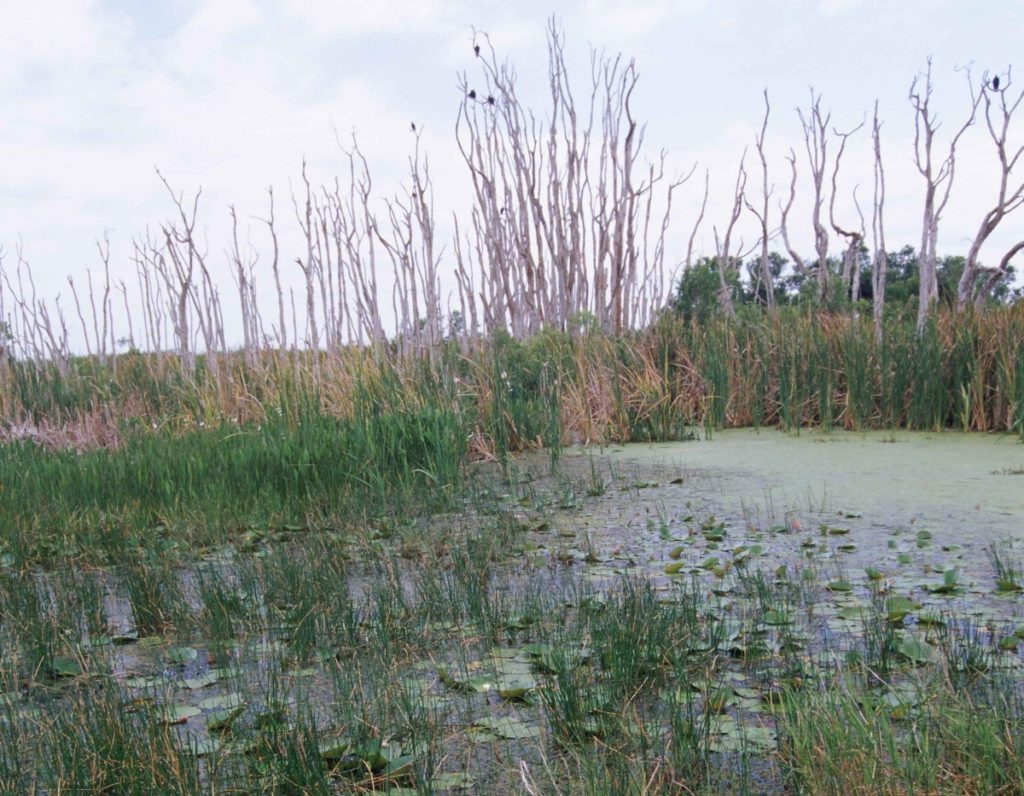
Your pond can get its nutrients from many different sources. Sometimes, your pond is part of or at the edge of very nutrient-rich lowlands. When this is the case, you will have a more difficult time removing nutrients because nutrients are constantly leaching in from the adjoining lowlands.
The Wind
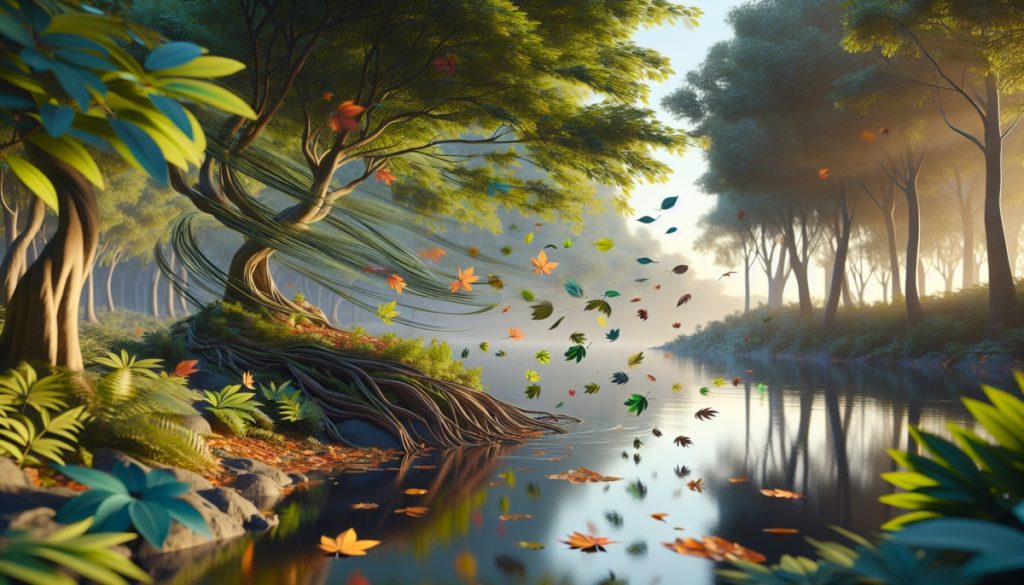
If your pond is not part of or adjacent to a natural swamp or marsh, you will have an easier time reducing the nutrient levels. One key strategy is to keep the nutrients from entering your pond in the first place. The wind carries nutrients into our ponds in the form of leaves, lawn clippings, and any other light debris that can become airborne. Any pond owner knows that leaves stick to pond water like glue, so if you can plant some evergreen trees on the windward side of your pond, these will cut down on some of the airborne nutrients entering your pond.
Runoff
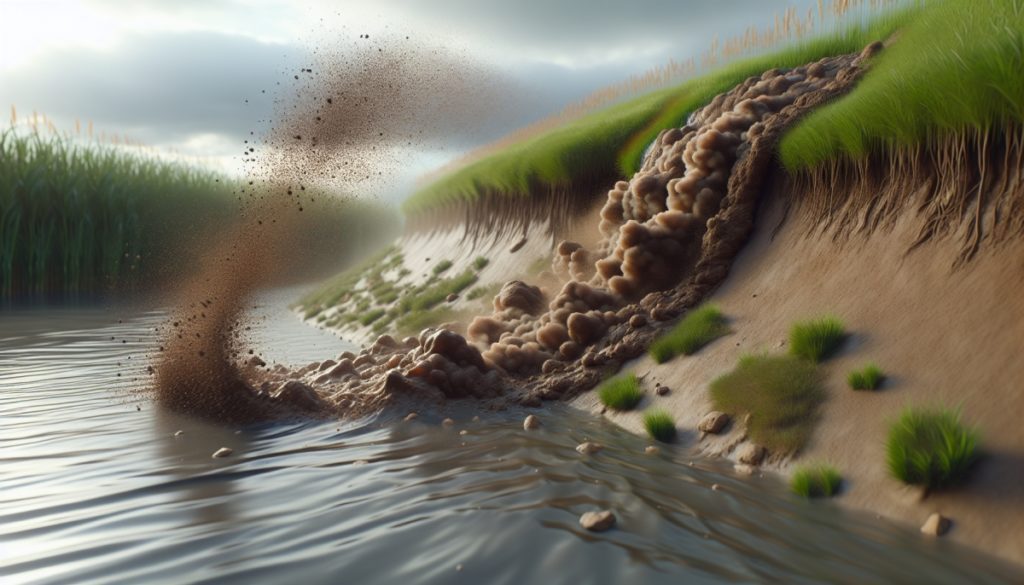
Another source of nutrients is runoff. Oftentimes, our ponds are located in a low spot in the yard. This only makes sense since water always flows downhill, but it causes problems every time we get a good rain. Any runoff water entering your pond carries nutrients, so reducing runoff is a good approach. Sometimes runoff water can be diverted to miss the pond with a few simple swales, and sometimes we can slightly build up areas adjacent to the pond edge to help divert the water.
If you can’t reduce the amount of runoff entering your pond, you can still reduce the amount of nutrients the water carries. This can be accomplished by filtering the runoff through plants on the way to the pond. Planting lush and thick groupings of grasses, perennial flowers and shrubs can slow runoff. The more that we can slow down the flowing runoff water and meander it through plants, the more nutrients will be left on land rather than in the pond.
Your Lawn
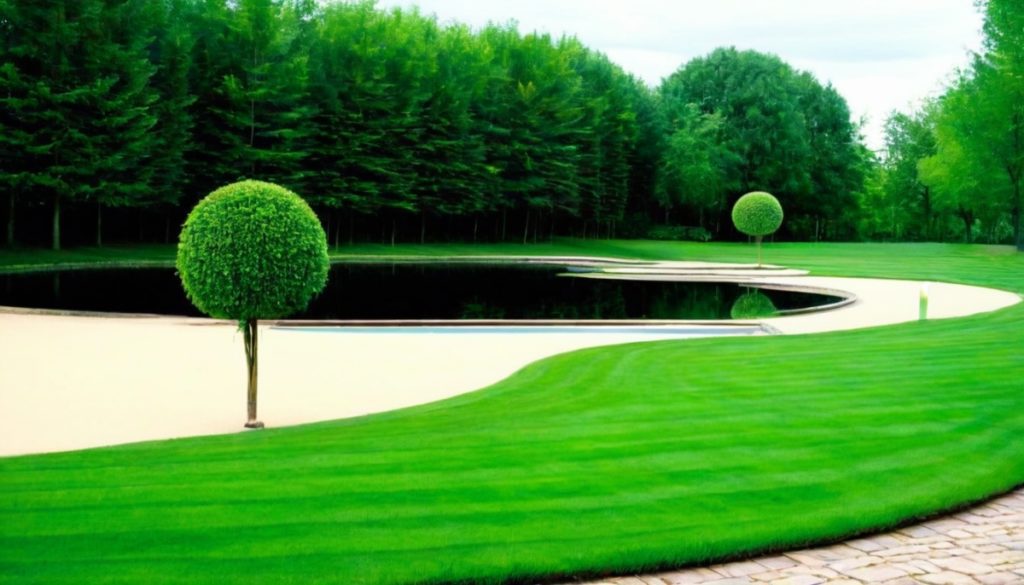
If you love having the lushest green grass in the neighborhood, neatly trimmed right up to the edge of the pond water, then this is surely part of the problem. Mowing right to the edge of the pond has several negative effects on water quality. The act of mowing is sure to deposit grass clippings into the pond. Even if you blow them away from the pond, wind and rain will still carry some into the pond. Secondly, mowing the lawn right up to the edge is definitely better than having bare dirt up to the edge, but taller grasess and even weeds would help to keep more nutrients from the water. Above all, lawn fertilizer entering the pond water is by far the worst effect of mowing to the edge. Lawn fertilizers running into your pond could be the main reason that you have duckweed and algae in your pond. There is no cure for a bunch of synthetic lawn fertilizer in the pond. That stuff is designed to make your grass bright green, and it will do the same to your pond, every time. Do yourself a favor and make sure that no fertilizers or other chemicals are used uphill from your pond.
Muck

Once we minimize the amount of nutrients entering the pond, we need to start looking into the pond water. If you have an older pond or a pond that has been chemically treated, then it is highly likely that you have a thick layer of muck on the pond bottom. This muck is made up of every dead organism that has ever made its way into your pond, including algae, plants, and organisms that have been killed off by chemicals over the years.
If your pond has a liner, you could certainly pump out the water and clean out all of the muck. This will definitely solve your nutrient problem, but believe me when I say that this can be a huge and overwhelming task. If your pond has a natural bottom, you can either dredge it out or start some natural treatments to decompose the muck.
The Solution(s)
Oxygen and Bacteria
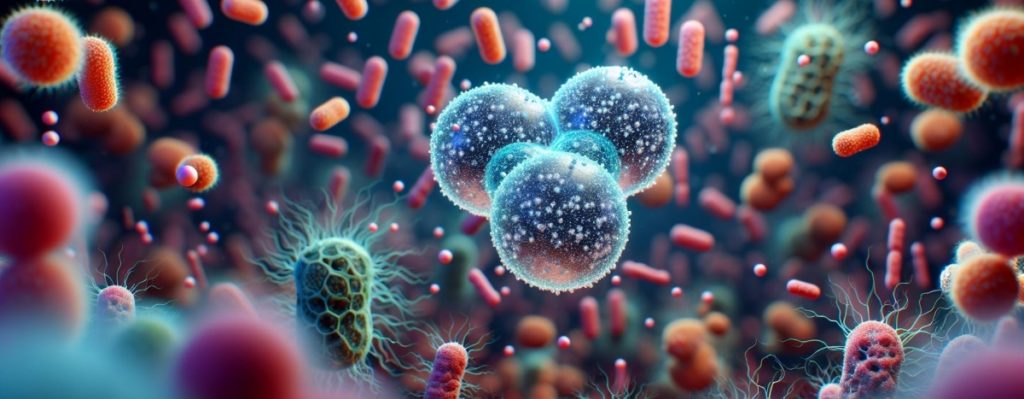
The absolute best way to lower your nutrient levels is to get high levels of oxygen and bacteria to the bottom of your pond. Having this combo at the pond bottom will significantly reduce the amount of nutrients in the pond, which will dramatically reduce the amount of duckweed that you can grow in your pond. Less nutrients will always mean less duckweed.
So, how do we get high oxygen and bacteria levels down to your pond’s bottom? Well, the answers are bottom aeration and bacterial treatments. Given time, this is a surefire way to lower the nutrient levels in your pond. It isn’t going to happen overnight, but given time, it will work.
Installing a bottom aeration system or an oxygen saturation system will do the trick to aerate the pond bottom. Once we raise the oxygen levels, we can increase the bacteria levels by adding a bunch of sinking bacteria to the water. This natural bacteria has a varied mix of fast-working bacteria that will work to decompose all of that stinky muck at the pond bottom.
BioBoost Nest
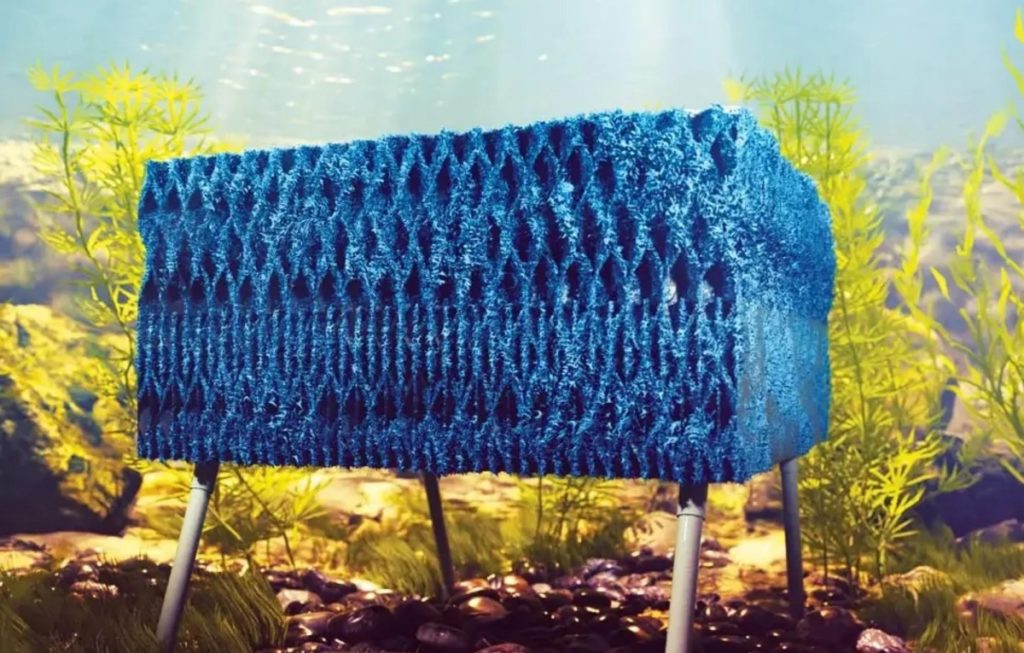
To go one step further and speed up the process even more, we can install BioBoost nests near the bottom aeration. These bacteria colonization units will make it easy for large quantities of bacteria to colonize near the pond bottom, which will increase the amount of nutrients removed and will make your bacterial applications more effective.
Fountain
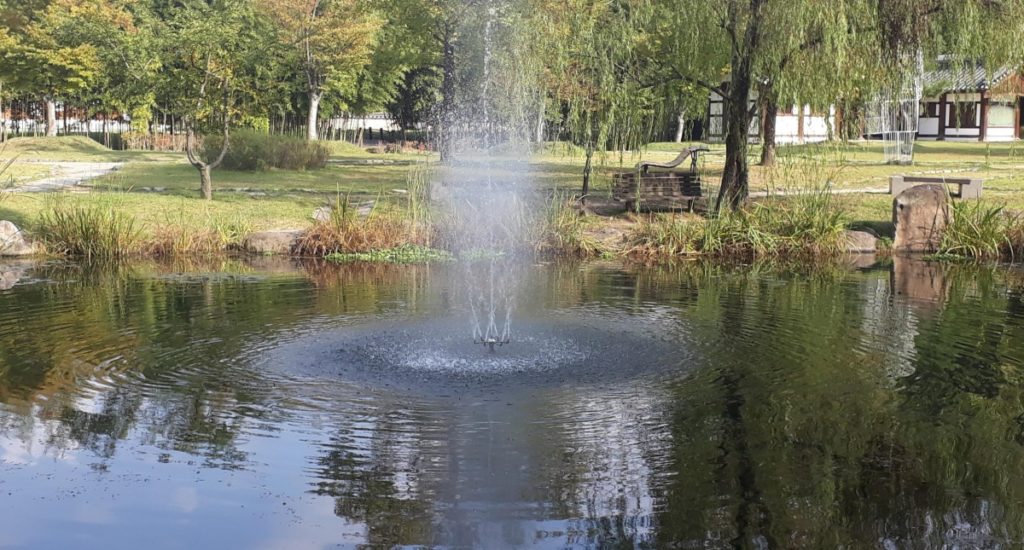
Another method of aeration that will have an immediate impact on your duckweed population is fountain aeration. A floating fountain throwing water into the air will not only increase the water’s oxygenation but also create a bunch of circulating water, which will help to reduce the duckweed population. Duckweed thrives in calm water.
Plants
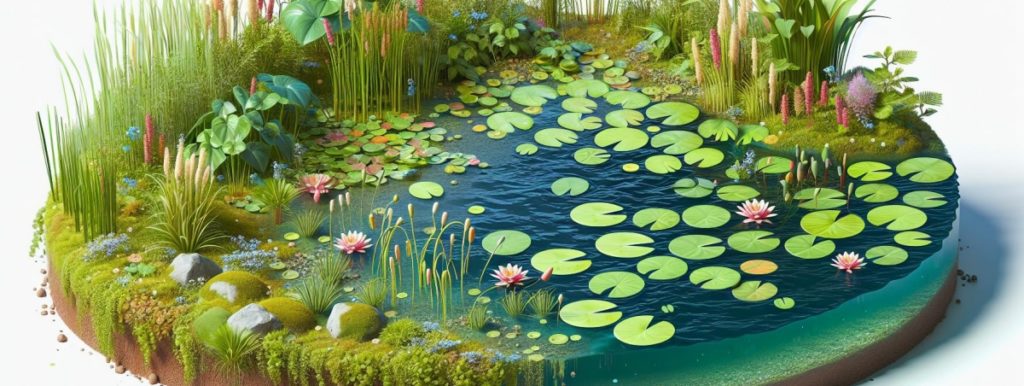
In addition to all of the above, you can add aquatic plants to your pond. If you can get a bunch of aquatic plants growing in our pond, you will have plants that you like, directly competing with the duckweed for nutrients. The easiest way to do this in a lined pond is to plant marginal aquatic plants in the shallow water areas of the pond.
Plant Islands

If you have an unlined pond, it is best to install floating plant islands. These large rafts float in the pond, allowing plant roots to hang down into the water which will take nutrients from the pond water as the plants grow. These floating islands mimic nature’s floating bogs that you may have come across in some Wisconsin lakes. Using plant islands rather than planting directly into the bottom of a natural pond simply reduced the amount of maintenance in the future. Aquatic plants will still grow in your natural bottom ed pond, but the plant islands make it easy to add a bunch of plants with worrying about them spreading and being hard to control.
Wetland Filter
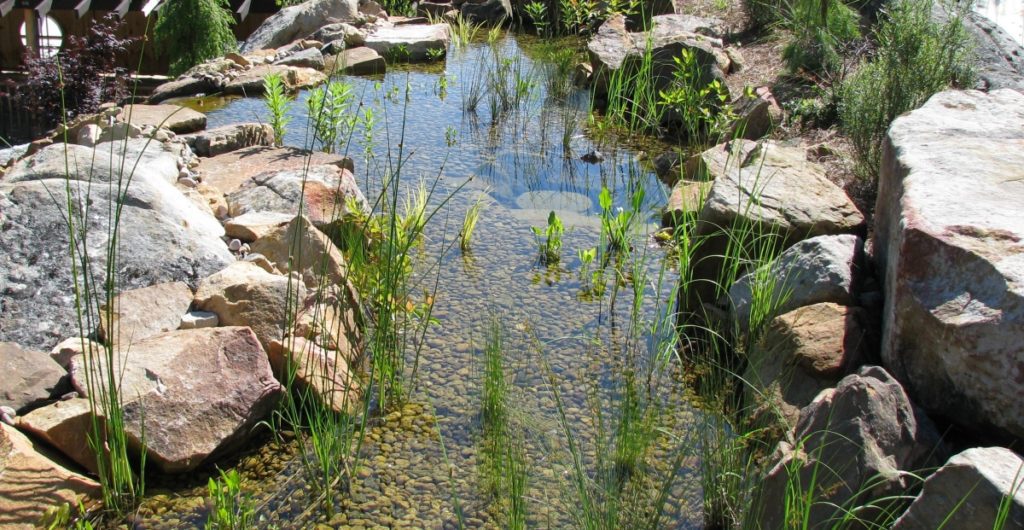
As long as we are talking about plants, depending on the location and set-up of your pond, you may want to consider installing an up-flow wetland filter. This is a big rubber-lined area that we fill with gravel and aquatic plants. We then circulate your pond water through the wetland, which helps remove even more nutrients from the water and gives you a great way to add aeration and a nice stream or waterfall to your pond.
Conclusion
A pond full of duckweed is never easy to combat, It looks ugly and can be quite overwhelming. Sometimes, our first reaction is to try to kill the plants using chemicals, but by doing this, we are causing more problems. All of that dead plant material will sink to the bottom and fertilize our next round of duckweed. If we can be patient, we can combat the problem naturally and have a healthier pond. By using all of these techniques, you can certainly get it under control. The first year or so will be the hardest. Once you have it under control, as long as you continue to keep nutrient levels low, your duckweed will have a tough time taking control of your pond. As your pond gets closer to its original, healthy, low-nutrient pond water, it will only get easier and easier over time.

